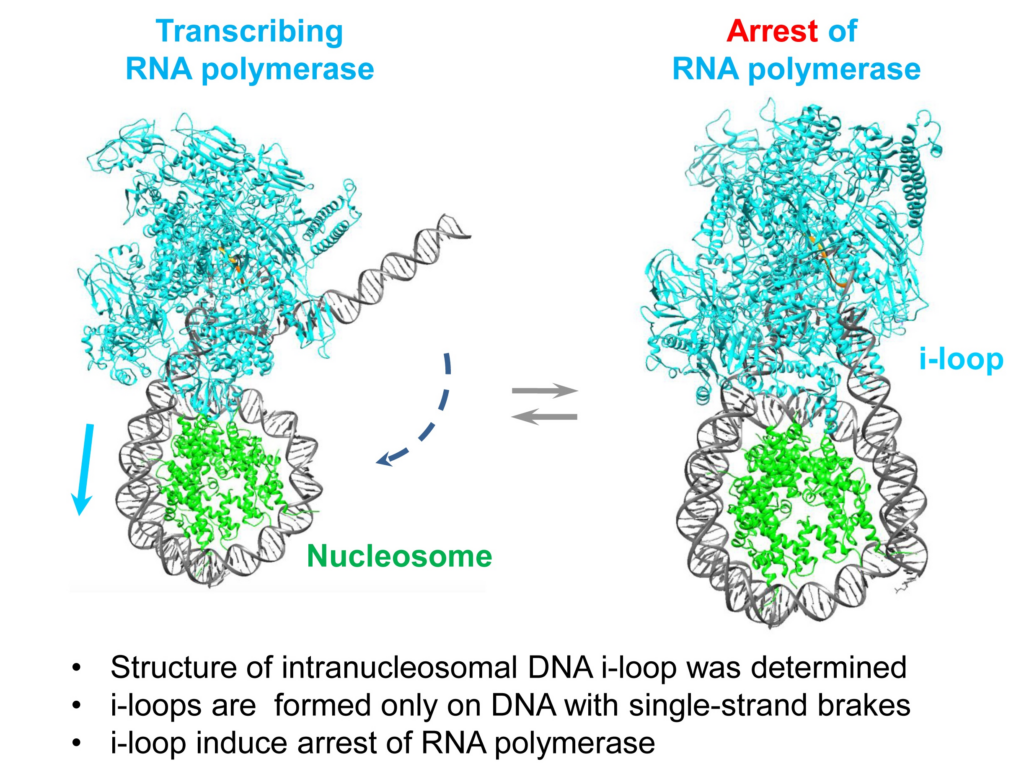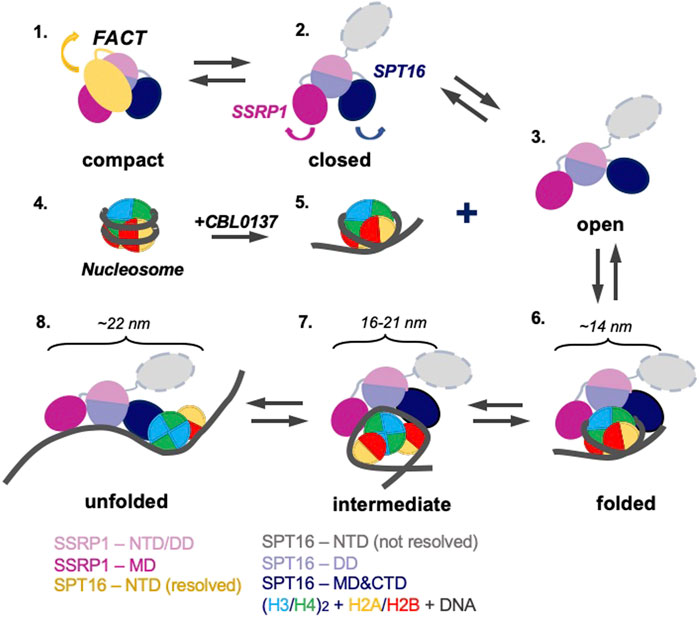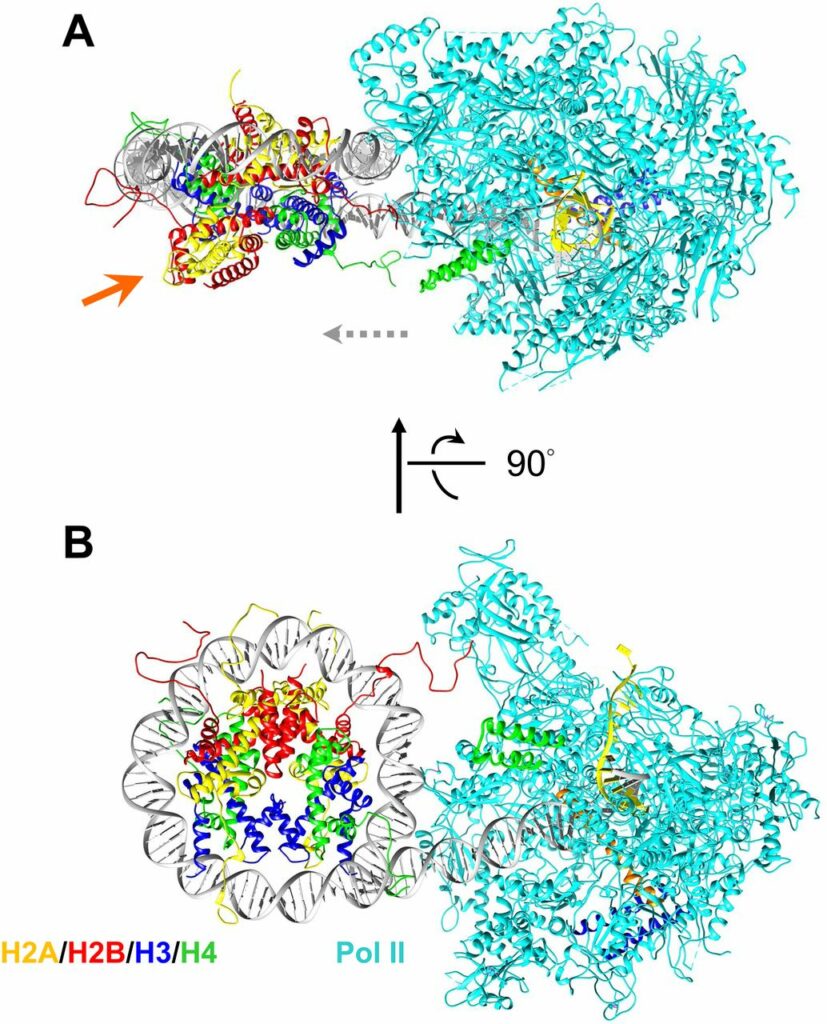Хроматин
Хроматин играет ключевую роль в упаковке генетической информации и ее доступности для транскрипции. Изменения в структуре хроматина могут влиять на экспрессию генов, что, в свою очередь, связано с различными физиологическими процессами и заболеваниями, включая рак. Понимание механизмов, регулирующих структуру хроматина, позволяет ученым выявлять молекулярные мишени для терапии и разрабатывать новые подходы к лечению заболеваний, связанных с нарушениями в регуляции генов. Таким образом, исследование хроматина является важной областью в молекулярной биологии и генетике, открывающей новые горизонты для медицинских исследований.
Публикации группы по направлению
Structure of an Intranucleosomal DNA Loop That Senses DNA Damage during Transcription
Nadezhda S. Gerasimova, Olesya I. Volokh, Nikolay A. Pestov, Grigory A. Armeev, Mikhail P. Kirpichnikov, Alexey K. Shaytan, Olga S. Sokolova and Vasily M. Studitsky
Transcription through chromatin by RNA polymerase II (Pol II) is accompanied by the formation of small intranucleosomal DNA loops containing the enzyme (i-loops) that are involved in survival of core histones on the DNA and arrest of Pol II during the transcription of damaged DNA. However, the structures of i-loops have not been determined. Here, the structures of the intermediates formed during transcription through a nucleosome containing intact or damaged DNA were studied using biochemical approaches and electron microscopy. After RNA polymerase reaches position +24 from the nucleosomal boundary, the enzyme can backtrack to position +20, where DNA behind the enzyme recoils on the surface of the histone octamer, forming an i-loop that locks Pol II in the arrested state. Since the i-loop is formed more efficiently in the presence of SSBs positioned behind the transcribing enzyme, the loop could play a role in the transcription-coupled repair of DNA damage hidden in the chromatin structure. DOI

Mechanism of curaxin-dependent nucleosome unfolding by FACT
Olesya I. Volokh, Anastasia L. Sivkina, Andrey V. Moiseenko, Anna V. Popinako, Maria G. Karlova, Maria E. Valieva, Elena Y. Kotova, Mikhail P. Kirpichnikov, Timothy Formosa, Vasily M. Studitsky, Olga S. Sokolova
Human FACT (FACT) is a multifunctional histone chaperone involved in transcription, replication and DNA repair. Curaxins are anticancer compounds that induce FACT-dependent nucleosome unfolding and trapping of FACT in the chromatin of cancer cells (c-trapping) through an unknown molecular mechanism. Here, we analyzed the effects of curaxin CBL0137 on nucleosome unfolding by FACT using spFRET and electron microscopy. By itself, FACT adopted multiple conformations, including a novel, compact, four-domain state in which the previously unresolved NTD of the SPT16 subunit of FACT was localized, apparently stabilizing a compact configuration. Multiple, primarily open conformations of FACT-nucleosome complexes were observed during curaxin-supported nucleosome unfolding. The obtained models of intermediates suggest “decision points” in the unfolding/folding pathway where FACT can either promote disassembly or assembly of nucleosomes, with the outcome possibly being influenced by additional factors. The data suggest novel mechanisms of nucleosome unfolding by FACT and c-trapping by curaxins. DOI

Structural analysis of nucleosomal barrier to transcription
Daria A. Gaykalova, Olga I. Kulaeva, Olesya Volokh, Alexey K. Shaytan, Fu-Kai Hsieha, Mikhail P. Kirpichnikov, Olga S. Sokolova and Vasily M. Studitsky
Thousands of human and Drosophila genes are regulated at the level of transcript elongation and nucleosomes are likely targets for this regulation. However, the molecular mechanisms of formation of the nucleosomal barrier to transcribing RNA polymerase II (Pol II) and nucleosome survival during/after transcription remain unknown. Here we show that both DNA–histone interactions and Pol II backtracking contribute to formation of the barrier and that nucleosome survival during transcription likely occurs through allosterically stabilized histone–histone interactions. Structural analysis indicates that after Pol II encounters the barrier, the enzyme backtracks and nucleosomal DNA recoils on the octamer, locking Pol II in the arrested state. DNA is displaced from one of the H2A/H2B dimers that remains associated with the octamer. The data reveal the importance of intranucleosomal DNA–protein and protein–protein interactions during conformational changes in the nucleosome structure on transcription. Mechanisms of nucleosomal barrier formation and nucleosome survival during transcription are proposed. DOI
